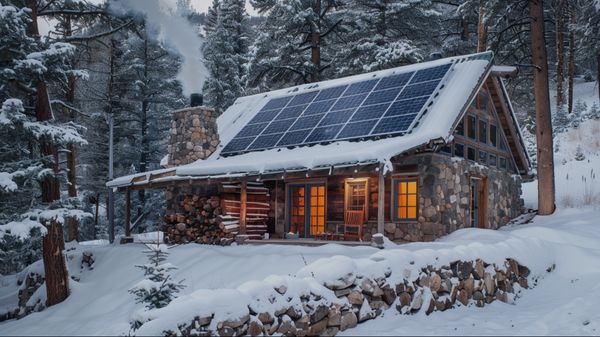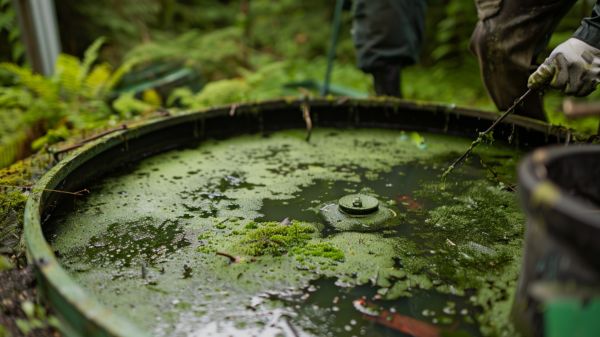For effective off-grid heating in cold climates, consider several options to guarantee efficiency and sustainability. Solar heating uses active systems like flat-plate or evacuated tube collectors combined with heat pumps for ideal performance year-round. Geothermal heating draws constant underground temperatures, offering over 400% efficiency without needing backup heat in extreme cold.
Advanced heat pumps, such as the Mitsubishi Hyper-Heating H2i, work efficiently in temperatures as low as -30°C, with features like variable speed compressors enhancing performance. Wood-burning stoves provide a reliable, electricity-free option. Explore diverse methods and configurations to tailor the best solution for your needs.
Key Takeaways
- Solar heating systems with antifreeze protect against freezing and provide efficient heating in cold climates.
- Geothermal heating offers sustainable off-grid solutions with high efficiency, utilizing stable underground temperatures.
- Advanced heat pumps function effectively in extreme cold, maintaining efficiency significantly better than traditional systems.
- Wood-burning stoves deliver reliable heat off-grid, especially during power outages, with modern models achieving high efficiency.
- Proper insulation enhances heat retention and reduces energy consumption, crucial for maintaining comfort in off-grid scenarios.
Solar Heating Solutions
Solar heating solutions offer a versatile and eco-friendly way to warm your home while reducing energy costs. By choosing the right solar collector types, you can enhance your system’s heating efficiency improvements and guarantee peak performance year-round.
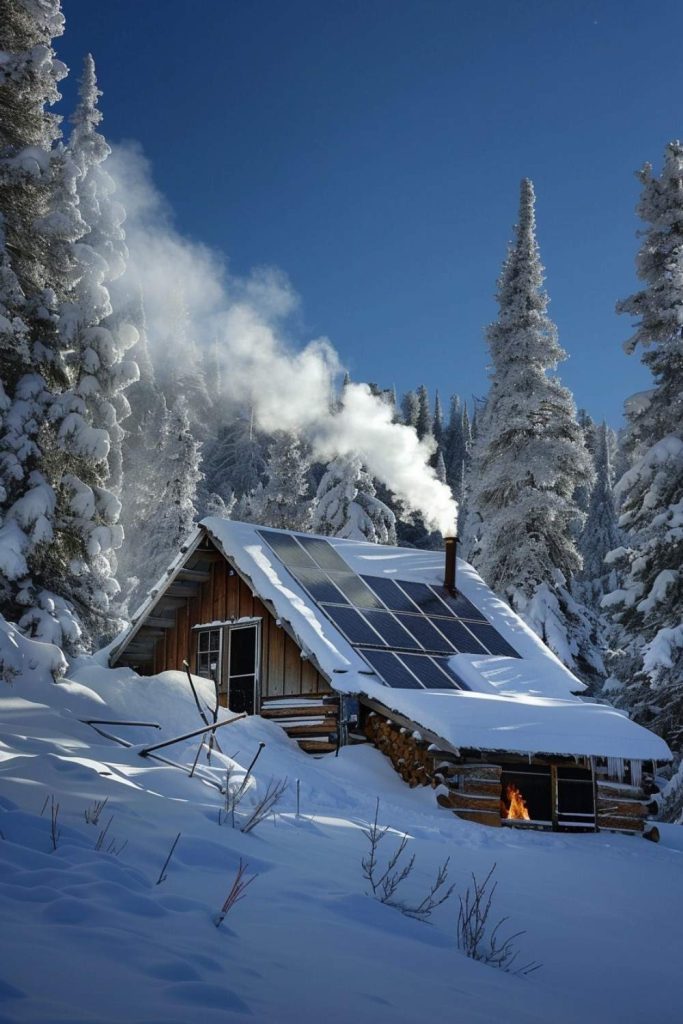
Solar heating systems are particularly cost-effective in cold climates where they replace more expensive heating fuels like electricity and oil.
- Active Solar Systems: These systems use collectors to heat a fluid, which transfers heat directly to your living space. Popular collector types include flat-plate, evacuated tube, and transpired air collectors. Essential components like inverters and charge controllers can impact the energy conversion efficiency of these systems.
- Efficiency Benefits: Solar heating can considerably cut winter fuel bills and reduce greenhouse gas emissions. Systems can also heat domestic water, boosting efficiency by using collectors even in summer.
- Design for Cold Climates: Active closed-loop systems with antifreeze solutions, like polypropylene glycol, prevent freezing and pipe damage. Evacuated tube collectors, known for minimizing heat loss, are ideal for sub-zero conditions.
- Installation and Maintenance: Proper configuration and regular maintenance guarantee long-term cost-effectiveness. By incorporating solar heating systems with cold-climate heat pumps, homeowners can achieve even greater efficiency and savings in heating and cooling costs.
Exploring Geothermal Heating
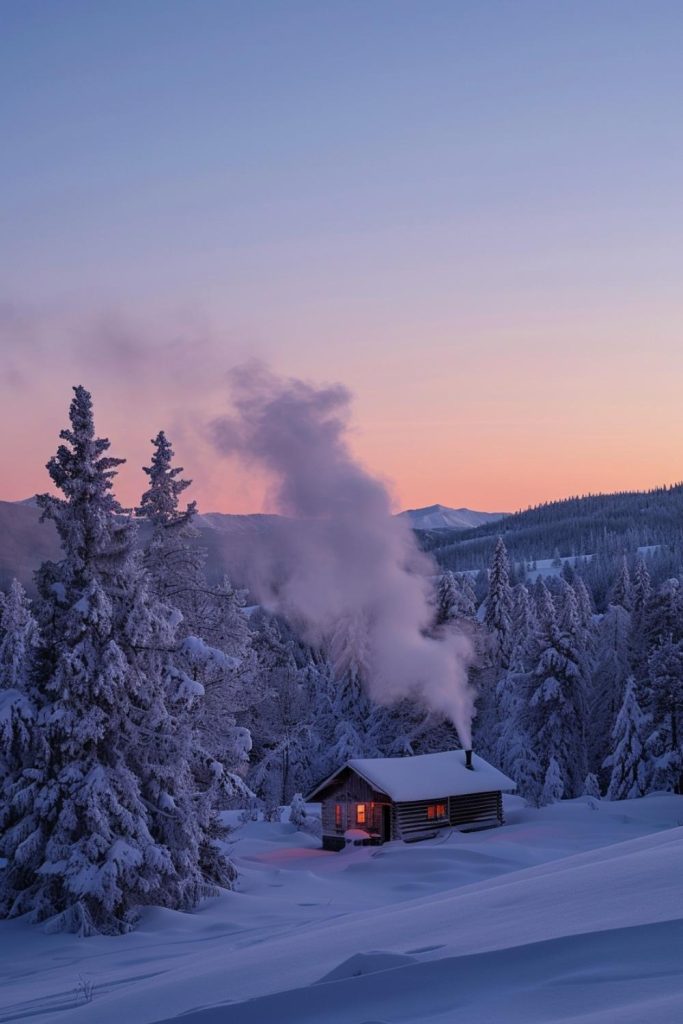
When seeking an efficient and sustainable heating option, geothermal heating stands out as a remarkable choice. This system leverages the Earth’s consistent underground temperature, around 55°F, to heat your home.
Geothermal systems are highly efficient in cold climates, including Canadian winters. Here’s how it works: a closed-loop system of pipes buried underground circulates refrigerant, extracting heat efficiently, even in the coldest climates.
With geothermal advantages like over 400% efficiency, you can save 30-70% on heating costs compared to traditional systems, reducing your reliance on fossil fuels and minimizing carbon emissions.
However, installation challenges exist. Geothermal systems require significant upfront investment due to the complexity of installing underground loops. Yet, this initial cost is balanced by long-term savings and reduced maintenance requirements.
Unlike air-source heat pumps, geothermal systems don’t need a backup heating source in extreme cold, making them more reliable in harsh climates. To guarantee you get the most out of your system, focus on:
- Proper home insulation
- Regular maintenance of air filters and coils
- Consistent operation at a set temperature
Remember to prioritize proper sizing, as this guarantees peak performance without needing additional heating. With geothermal heating, you join a community dedicated to sustainable and efficient living.
Wood-Burning Stove Benefits
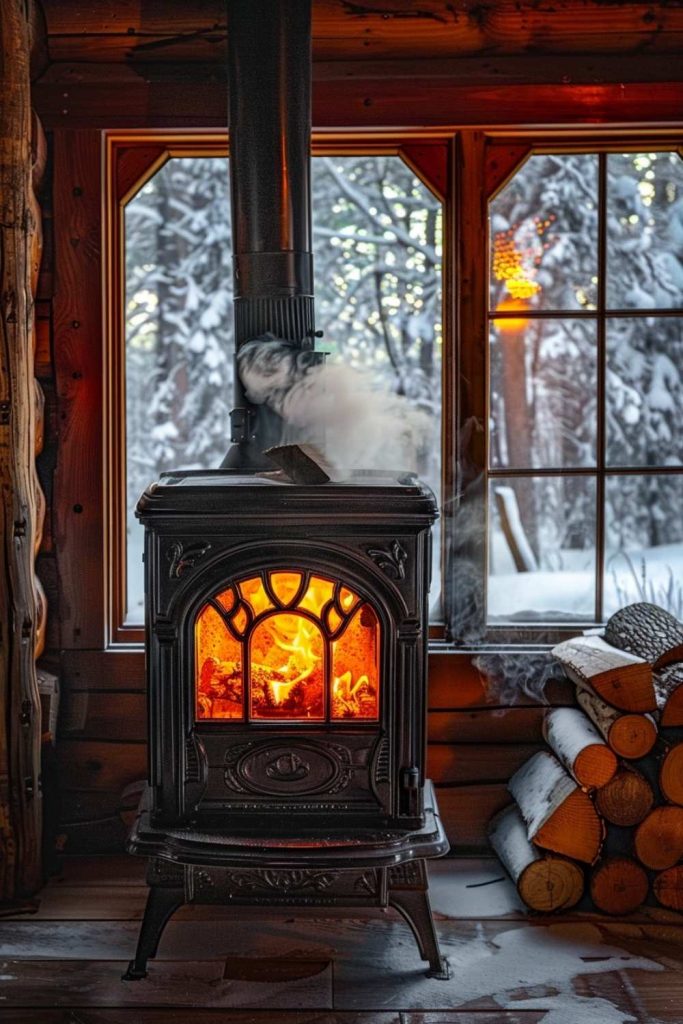
While geothermal heating offers a sustainable option, wood-burning stoves provide a reliable alternative for those seeking off-grid heating solutions. They don’t need electricity, guaranteeing warmth even during power outages.
Modern wood stoves boast impressive wood stove efficiency, with post-2020 models emitting minimal particulates, guaranteeing cleaner air. If you’re looking for a heating method that radiates warmth evenly and rapidly, a wood stove is an excellent choice, achieving up to 83% HHV efficiency and reducing emissions.
Wood stoves are especially beneficial in regions like New Hampshire and New England, where their robust heating performance ensures residents stay warm during harsh winters.
In parallel to these traditional off-grid heating solutions, advancements in renewable energy technologies, such as off-grid solar systems, are emerging as sustainable alternatives for colder climates.
To maximize these benefits, consider these operational tips:
- Choose the Right Fuel: Opt for wood types like fir, larch, or beech for ideal burn times.
- Size Matters: Confirm the stove is correctly sized for your space to prevent waste.
- Regulate Air Supply: Proper air supply management enhances efficiency.
Chimney maintenance is essential for safe operation. Regular cleaning prevents residue buildup, reducing fire risks. Installations are straightforward, but professional assistance guarantees safety and compliance with EPA standards. The cost-effectiveness of wood stoves lies in affordable fuel and reduced electricity consumption.
Advanced Heat Pump Options
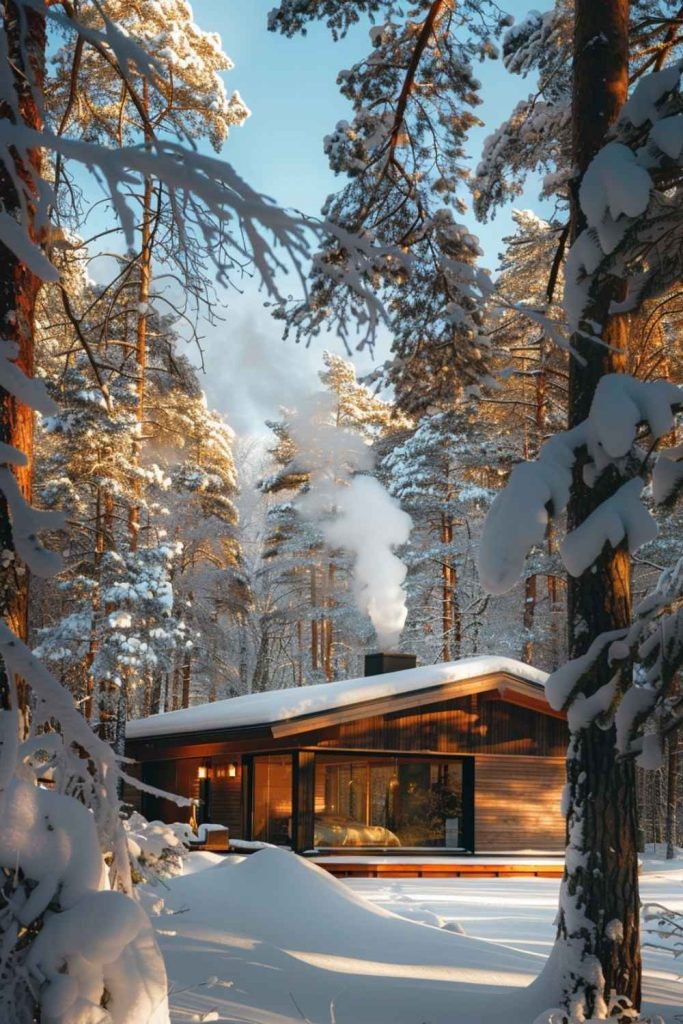
Advanced heat pump options offer a versatile and efficient solution for off-grid heating, especially in cold climates. You’ll find that these systems are meticulously designed to maintain high heat pump efficiency, even when temperatures plummet below zero.
Cold climate performance is a key feature, with models like Mitsubishi’s Hyper-Heating H2i technology providing reliable warmth down to -25°C. The high Coefficient of Performance (COP) guarantees that, even under extreme conditions, these pumps perform efficiently, often three times better than traditional systems.
While they are energy-efficient alternatives to traditional HVAC systems, efficiency declines as outdoor temperatures drop, and they may require supplemental heating in extreme cold.
| Feature | Benefit |
|---|---|
| Cold Climate Heat Pumps | Operate efficiently at -30°C |
| Variable Speed Compressors | Adjust speed for ideal efficiency |
| Intelligent Defrosting Systems | Prevent ice buildup on coils |
To achieve ideal performance, it’s essential to have professional installation and regular maintenance. Advanced features such as variable speed compressors and enhanced coil designs maximize heat absorption and energy savings.
Pair these with smart controls like programmable thermostats, and you’ll achieve significant cost savings and comfort. Additionally, these units are compact and quiet, fitting seamlessly into your home.
With extensive warranties and government incentives, advanced heat pumps not only align with sustainable living but also offer a cost-effective, eco-friendly heating solution.
Diverse Off-Grid Heating Methods
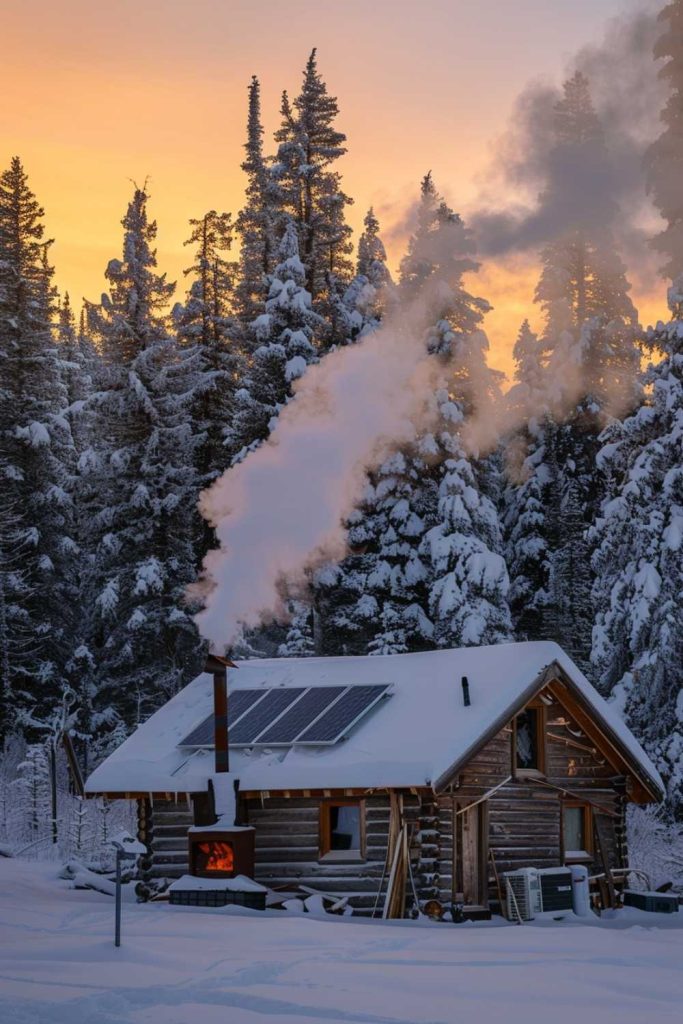
Exploring diverse off-grid heating methods reveals a tapestry of traditional, solar-based, and renewable energy-powered solutions that cater to various needs and preferences.
When you consider propane heaters, you’re tapping into propane efficiency, as these heaters provide reliable space and water heating. They do, however, require regular propane purchases and storage.
Oil boilers, another traditional option, burn heating oil and also rely on consistent fuel supply and storage. For those inclined towards more natural methods, wood-burning stoves and biomass boilers offer distinct advantages.
Wood-burning stoves are low-tech and low-cost, requiring minimal maintenance. Biomass boilers, adaptable to various materials like logs and straw, capitalize on biomass advantages, providing a sustainable heating source.
Solar-based options like active solar heating and solar thermal panels use solar energy directly, while passive solar heating maximizes natural sunlight through strategic design. Insulation is essential for heat retention; consider higher R-values for improved performance in cold climates.
For a more innovative approach, consider radiant floor heating and solar heat pumps. Renewable energy-powered heating includes geothermal and air source heat pumps, utilizing stable earth temperatures and outside air, respectively.
These can align with solar power setups, especially when considering off-grid solar systems with batteries for effective energy storage and independence. Portable units and thermosiphon systems offer additional flexibility, ensuring warmth even in off-grid settings.
Frequently Asked Questions
What Are the Initial Costs for Installing Off-Grid Heating Systems?
You’re curious about the initial costs for off-grid heating systems, right? Let’s break it down. For solar heating, you’ll spend between $2,000 and $30,000 depending on system type. Biomass boilers, like wood stoves, range from $1,000 to $5,000.
Remember, installation costs vary by location and system size. Consider these expenses to guarantee a warm, cozy space. Evaluate your options carefully to create a sustainable, efficient off-grid heating solution.
Can Off-Grid Heating Systems Integrate With Existing Home Infrastructure?
Imagine you’ve got a cozy cabin. You can seamlessly integrate a solar thermal panel system with your existing water heater.
This setup offers system compatibility and energy efficiency by using the sun’s energy to heat water, reducing reliance on traditional power sources.
When planning, consider:
- Compatibility with existing infrastructure.
- Adequate space for solar panels.
- Insulation needs.
This integration not only saves energy but also connects you to a sustainable community.
How Do Off-Grid Heating Systems Perform in Extreme Cold Conditions?
You’ll find off-grid heating systems perform admirably in extreme cold conditions, especially when considering performance metrics and efficiency comparisons.
High-efficiency heat pumps maintain effectiveness even at subzero temperatures, thanks to features like inverter compressors.
Ground source heat pumps excel using Earth’s natural heat, while radiant floor heating provides consistent warmth.
Additionally, solar panels paired with radiant heating offer a sustainable option. These systems guarantee you stay warm with minimal environmental impact and cost.
What Are the Maintenance Requirements for Off-Grid Heating Systems?
To maintain off-grid heating systems efficiently, you’ll need to focus on system efficiency and fuel sourcing. Regularly clean solar panels, inspect geothermal loops, and check propane lines.
Make sure wood stoves are free of flue buildup, and change oil filters in boilers. For reliability, monitor radiant floor heating fluid levels and adjust solar panel angles.
Safety measures include installing carbon monoxide detectors for wood stoves and gas detectors for propane systems, guaranteeing safe operation.
Are There Government Incentives for Adopting Off-Grid Heating Solutions?
When it comes to adopting renewable energy, you’re in luck—government incentives can be the wind beneath your wings.
Federal and provincial programs offer tax credits and rebates for energy-efficient upgrades.
- Canada Greener Homes Initiative: Provides interest-free financing and up to $10,000 for heat pump conversions.
- Ontario Energy Affordability Program: Offers free heat pumps to eligible households.
- Home Efficiency Rebate Plus: Up to $5,000 in rebates for upgrades.
These incentives make renewable energy adoption more accessible and affordable.
Conclusion
In the icy grip of winter, your quest for the ultimate off-grid heating solution transforms into an epic journey through a domain of endless possibilities. From harnessing the sun’s boundless energy with solar heating systems to delving deep into the Earth’s core with geothermal options, you’re equipped to conquer any chill.
Embrace the rugged charm of wood-burning stoves and cutting-edge heat pumps, and explore diverse methods to guarantee your warmth, independence, and sustainability in even the harshest climates.

